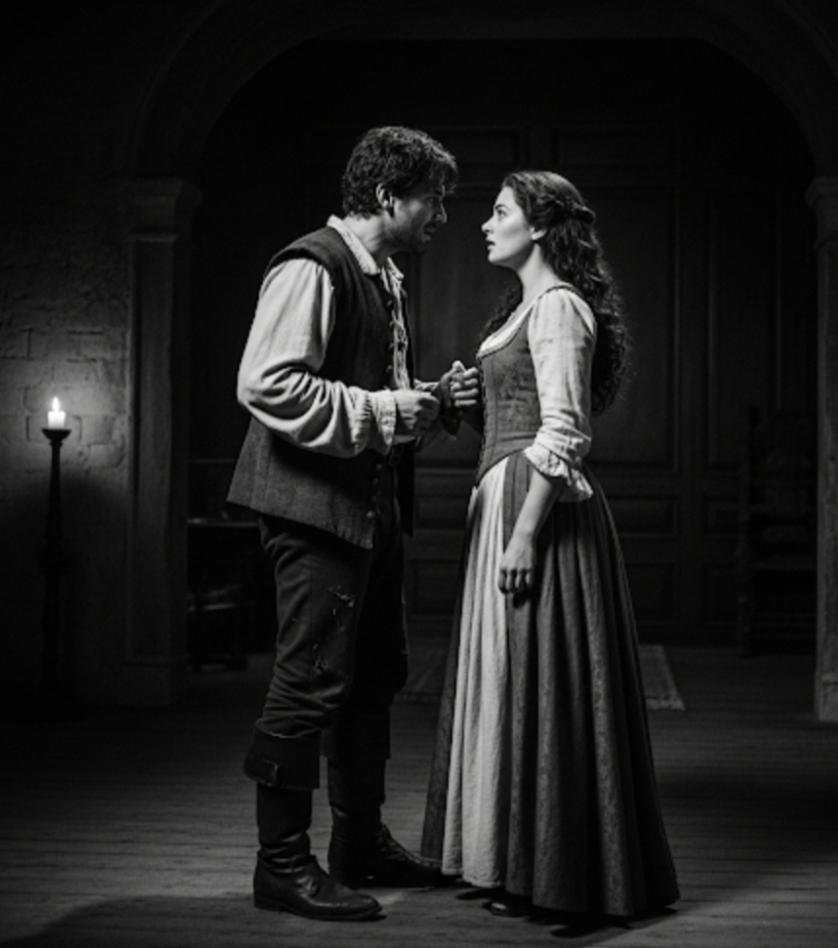Love and Fortune: The Hidden Nobility of Teodoro and Violante
INTRODUCTION
The Decameron is a classic 14th-century collection of 100 tales written by the Italian author Giovanni Boccaccio. Set during the Black Death plague of 1348, it frames the stories as being told by a group of seven young women and three young men. Over ten days, each person tells one story per day, during the fifth day Fiammetta, whose name means small flame, sets the theme of tales where lovers pass through disasters before having their love end in good fortune.
SUMMARY
Teodoro is sold to Messer Amerigo as a slave when still a child. He is christened and brought up together with Violante, the daughter of his master. The two fall in love and Violante eventually bears a boy. Threatened with death by her outraged father she names the father who is sentenced to the gallows. Amerigo orders his daughter to kill herself by knife or poison after which a servant will kill her baby. Traveling Armenian dignitaries recognize the condemned Teodoro by a strawberry shaped birth mark. It was revealed that Teodoro is not a slave but a nobleman. His life is saved as well as Violante's in the last minute. The couple get the blessing of their father, marry and live a happy life until old age.
ANALYSIS
The tale’s core moral revolves around the hardships of love and virtue despite many obstacles in. It signifies the role of fortune in human affairs like when people suffer injustices or calamities, destiny can intervene to restore justice and happiness. The tale also highlights the risks and unequal burdens faced by women in matters of love and family, especially under patriarchal authority.
The tale used irony in the reversal of fortune—Teodoro, initially a slave, is later revealed to be noble, which surprises both characters and readers. Humor arises from the unfolding of events that conflict with Messer Amerigo’s fury, providing a critique of excessive paternal authority. Symbolism is present in elements like the strawberry-shaped birthmark, representing identity and fate’s role in revealing truth and securing justice.
The tale reflects social hierarchies and concerns about legitimacy, family honor, and the social order, especially the limited agency of women and the power of paternal authority. The harsh punishments threatened by Messer Amerigo emphasizes the dangers women faced in disobeying societal norms. The story also reveals the unpredictability of fortune, which can create a big impact on people’s lives.
PERSONAL RESPONSE
The seventh tale of Day 5 in The Decameron tells a story opened my perspective about love and kindness. I liked how the characters, especially Teodoro and Violante, stayed true to their feelings even when things were difficult. Their love showed me that being honest and caring can help people face hard times. The story also made me think about how unfair it is when people judge others just because of their status, and how important it is to be fair and kind.
It is interesting how the story showed that power and control don’t always bring happiness. Instead, love and understanding are stronger and more important. The story’s ending gave me hope because it proves that good things can happen even if the situation looks bad. It reminded me that we should treat everyone with respect and look beyond appearances.
CONCLUSION
In conclusion, this tale teaches a simple but powerful lesson about love, fairness, and courage. It shows that even in hard moments, people can find happiness by being true to themselves and caring for others. This story from The Decameron encourages me to believe in kindness, hope and the perfect timing of destiny.
https://www.litcharts.com/lit/the-decameron/day-5-seventh-tale
#TheDecameron
#LiteraryReview
#MedievalLiterature
INTRODUCTION
The Decameron is a classic 14th-century collection of 100 tales written by the Italian author Giovanni Boccaccio. Set during the Black Death plague of 1348, it frames the stories as being told by a group of seven young women and three young men. Over ten days, each person tells one story per day, during the fifth day Fiammetta, whose name means small flame, sets the theme of tales where lovers pass through disasters before having their love end in good fortune.
SUMMARY
Teodoro is sold to Messer Amerigo as a slave when still a child. He is christened and brought up together with Violante, the daughter of his master. The two fall in love and Violante eventually bears a boy. Threatened with death by her outraged father she names the father who is sentenced to the gallows. Amerigo orders his daughter to kill herself by knife or poison after which a servant will kill her baby. Traveling Armenian dignitaries recognize the condemned Teodoro by a strawberry shaped birth mark. It was revealed that Teodoro is not a slave but a nobleman. His life is saved as well as Violante's in the last minute. The couple get the blessing of their father, marry and live a happy life until old age.
ANALYSIS
The tale’s core moral revolves around the hardships of love and virtue despite many obstacles in. It signifies the role of fortune in human affairs like when people suffer injustices or calamities, destiny can intervene to restore justice and happiness. The tale also highlights the risks and unequal burdens faced by women in matters of love and family, especially under patriarchal authority.
The tale used irony in the reversal of fortune—Teodoro, initially a slave, is later revealed to be noble, which surprises both characters and readers. Humor arises from the unfolding of events that conflict with Messer Amerigo’s fury, providing a critique of excessive paternal authority. Symbolism is present in elements like the strawberry-shaped birthmark, representing identity and fate’s role in revealing truth and securing justice.
The tale reflects social hierarchies and concerns about legitimacy, family honor, and the social order, especially the limited agency of women and the power of paternal authority. The harsh punishments threatened by Messer Amerigo emphasizes the dangers women faced in disobeying societal norms. The story also reveals the unpredictability of fortune, which can create a big impact on people’s lives.
PERSONAL RESPONSE
The seventh tale of Day 5 in The Decameron tells a story opened my perspective about love and kindness. I liked how the characters, especially Teodoro and Violante, stayed true to their feelings even when things were difficult. Their love showed me that being honest and caring can help people face hard times. The story also made me think about how unfair it is when people judge others just because of their status, and how important it is to be fair and kind.
It is interesting how the story showed that power and control don’t always bring happiness. Instead, love and understanding are stronger and more important. The story’s ending gave me hope because it proves that good things can happen even if the situation looks bad. It reminded me that we should treat everyone with respect and look beyond appearances.
CONCLUSION
In conclusion, this tale teaches a simple but powerful lesson about love, fairness, and courage. It shows that even in hard moments, people can find happiness by being true to themselves and caring for others. This story from The Decameron encourages me to believe in kindness, hope and the perfect timing of destiny.
https://www.litcharts.com/lit/the-decameron/day-5-seventh-tale
#TheDecameron
#LiteraryReview
#MedievalLiterature
Love and Fortune: The Hidden Nobility of Teodoro and Violante
INTRODUCTION
The Decameron is a classic 14th-century collection of 100 tales written by the Italian author Giovanni Boccaccio. Set during the Black Death plague of 1348, it frames the stories as being told by a group of seven young women and three young men. Over ten days, each person tells one story per day, during the fifth day Fiammetta, whose name means small flame, sets the theme of tales where lovers pass through disasters before having their love end in good fortune.
SUMMARY
Teodoro is sold to Messer Amerigo as a slave when still a child. He is christened and brought up together with Violante, the daughter of his master. The two fall in love and Violante eventually bears a boy. Threatened with death by her outraged father she names the father who is sentenced to the gallows. Amerigo orders his daughter to kill herself by knife or poison after which a servant will kill her baby. Traveling Armenian dignitaries recognize the condemned Teodoro by a strawberry shaped birth mark. It was revealed that Teodoro is not a slave but a nobleman. His life is saved as well as Violante's in the last minute. The couple get the blessing of their father, marry and live a happy life until old age.
ANALYSIS
The tale’s core moral revolves around the hardships of love and virtue despite many obstacles in. It signifies the role of fortune in human affairs like when people suffer injustices or calamities, destiny can intervene to restore justice and happiness. The tale also highlights the risks and unequal burdens faced by women in matters of love and family, especially under patriarchal authority.
The tale used irony in the reversal of fortune—Teodoro, initially a slave, is later revealed to be noble, which surprises both characters and readers. Humor arises from the unfolding of events that conflict with Messer Amerigo’s fury, providing a critique of excessive paternal authority. Symbolism is present in elements like the strawberry-shaped birthmark, representing identity and fate’s role in revealing truth and securing justice.
The tale reflects social hierarchies and concerns about legitimacy, family honor, and the social order, especially the limited agency of women and the power of paternal authority. The harsh punishments threatened by Messer Amerigo emphasizes the dangers women faced in disobeying societal norms. The story also reveals the unpredictability of fortune, which can create a big impact on people’s lives.
PERSONAL RESPONSE
The seventh tale of Day 5 in The Decameron tells a story opened my perspective about love and kindness. I liked how the characters, especially Teodoro and Violante, stayed true to their feelings even when things were difficult. Their love showed me that being honest and caring can help people face hard times. The story also made me think about how unfair it is when people judge others just because of their status, and how important it is to be fair and kind.
It is interesting how the story showed that power and control don’t always bring happiness. Instead, love and understanding are stronger and more important. The story’s ending gave me hope because it proves that good things can happen even if the situation looks bad. It reminded me that we should treat everyone with respect and look beyond appearances.
CONCLUSION
In conclusion, this tale teaches a simple but powerful lesson about love, fairness, and courage. It shows that even in hard moments, people can find happiness by being true to themselves and caring for others. This story from The Decameron encourages me to believe in kindness, hope and the perfect timing of destiny.
https://www.litcharts.com/lit/the-decameron/day-5-seventh-tale
#TheDecameron
#LiteraryReview
#MedievalLiterature
0 Kommentare
·0 Anteile
·137 Ansichten
·0 Vorschau



